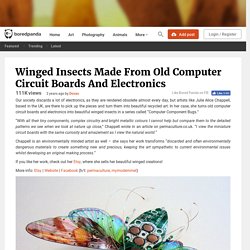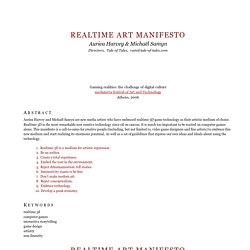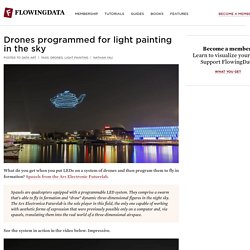

Art Emotions Map by Nicolas Barradeau, Romain Cazier, Artists in Residence at Google Arts & Culture Lab, Alan Cowen, U.C. Berkeley - Experiments with Google. Emotions help us respond to the world around us - to make decisions, understand people, avoid danger, and survive.

Emotions also help other people understand us. Arts & Culture Experiments - Experiments with Google. My Work.
Swirling wall of moving patterns represents our thoughts. Hacking for Artists. NOWNESS - Wow! Directed by 3D artist Tobias Gremmler... Harvest, clean cryptocurrencies for climate change. Julian Oliver, one of the main writers of the ‘Critical Engineering’ manifesto, has never given up on producing artworks with a concrete side, both universally applicable and opening a space of awareness and sense of contradiction in the public.

“Harvest” once more possesses these qualities. It uses a 2m wind turbine connected to a (weatherproof) computer, which is connected to the internet through a 4G uplink. The energy obtained from wind and storms feeds the computer requirements to mine a cryptocurrency (Zcash). The earned money then is donated to non-profit climate change research organisations. Marco Donnarumma. Surreal X-Ray Photographs Reveal Hidden Beauty in Nature. Our human eyes may be limited by visible light, but the work of physicist and artist Arie van 't Riet gives us a glimpse into the invisible universe around us.
In exploration of nature’s hidden anatomy, Riet uses x-ray imagery on naturalistic compositions, or bioramas, created from flora and fauna. The challenging photography process requires Riet to experiment with different levels of x-ray energies to achieve the right amount of contrast in each image. Spectacle, Speculation, Spam. All Things Fall - 3D printed zoetrope by Mat Collishaw. New York’s MoMA Acquires the First Ever (Very Pixelated) Emoji. As of this morning, the Museum of Modern Art in New York has acquired the original 176 emoji for its permanent collection.
Designed by Shigetaka Kurita for cell phones and pagers in 1999, they aren’t exactly the bouncy expressions that make today’s communication what it is. They’re more typographical, for one thing, and they only have six colors—red, orange, lilac, grass green, royal blue, and black. At just 12 pixels by 12 pixels, the glyphs might seem rudimentary (especially beside beer steins, eggplants, and piles of happy poop), but look closer and you’ll find that they’re remarkably efficient communicators. “They’re so incredibly beautiful and expressive, even though the technology at the time was so limited,” says Paola Antonelli, MoMA’s senior curator in the department of architecture and design. More than that, early emoji were also a marketing tool.
Winged Insects Made From Old Computer Circuit Boards And Electronics. Our society discards a lot of electronics, as they are rendered obsolete almost every day, but artists like Julie Alice Chappell, based in the UK, are there to pick up the pieces and turn them into beautiful recycled art.

Get Real: Real-Time + Art + Theory + Practice + History — George Braziller. Tale of Tales - Realtime Art Manifesto. Realtime art manifesto 1.

Realtime 3D is a medium for artistic expression. Games are not the only things you can make with realtime 3D technology.And modification of commercial games is not the only option accessible to artists. Realtime 3D is the most remarkable new creative technology since oil on canvas.It is much too important to remain in the hands of toy makers and propaganda machines.We need to rip the technology out of their greedy claws and put them to shame by producingthe most stunning art to grace this planet so far.
(And claim the name “game” for what we do even if it is inappropriate.)
Augumented Reality. Ardurino. Bloggs. Computer Vision. Digital Art. Interaction Design. Kinect. OpenFrameworks. Open Source. Other Pearltrees. Physics. Processing. Pure Data. Robotics. Sound. Tips & Trix. Tools. Video Projection Mapping. The Visible Human Project. MindRDR. CYMATICS - Science Vs. Music - Nigel Stanford. Bierstadt Drones. Emotiv - Brain Computer Interface Technology. The Structure Sensor is the first 3D sensor for mobile devices. 3D-ify Your World! Artist Manipulates 48 Pools Of Water With Her Mind. E-Traces: Ballet Slippers That Make Drawings From The Dancer’s Movements.
If you’re like me, then you may have been accused of dispensing some questionable moves in the vicinity of the dance floor.

I’ve always maintained that my critics simply couldn’t grasp the subtlety of my particular style of physical expression, and now I just may have a means of illustrating my point with an ingenious piece of wearable electronics by designer Lesia Trubat González called E-Traces. The concept of Electronic Traces is based on capturing dance movements and transforming them into visual sensations through the use of new technologies. To do this we focused on the ballet shoes themselves, which through the contact with the ground, and thanks to Lilypad Arduino technology, record the pressure and movement of the dancer’s feet and send a signal to an electronic device. NASA Posts a Huge Library of Space Sounds, And You're Free To Use Them.
Space is the place.

Again. And SoundCloud is now a place you can find sounds from the US government space agency, NASA. In addition to the requisite vocal clips (“Houston, we’ve had a problem” and “The Eagle has landed”), you get a lot more. There are rocket sounds, the chirps of satellites and equipment, lightning on Jupiter, interstellar plasma and radio emissions.
Visualizing Our Tech Worship With Giant Webs of Circuitry. Technological mandala 20 - Resonator, 2014.

Leonardo Ulian <div class="slide" data-slide-id="1579293" ><img title="" alt="" width="650px" src=" data-image-width="1200" data-image-height="900" /><p class="caption">Technological mandala 20 - Resonator, 2014. <span class="credit"><img class="photo" width="650px" src=" Leonardo Ulian </span></p><div class="desc"><div class="slide-counter"></div><div>Technological mandala 20 - Resonator, 2014.
For Italian artist Leonardo Ulian, this is our universe. At its center: a microchip. Drones programmed for light painting in the sky. What do you get when you put LEDs on a system of drones and then program them to fly in formation?

Spaxels from the Ars Electronic Futurelab. Spaxels are quadcopters equipped with a programmable LED system. They comprise a swarm that’s able to fly in formation and “draw” dynamic three-dimensional figures in the night sky. Dances With Google Glass In June 2013, Google launched a competition on Twitter soliciting bids from people interested in beta-testing its latest foray into wearable high tech.

Since 'beta-tester' conjures up visions of bearded geeks in hoodies glued to their Retina displays, some marketing genius at Google coined the term 'Google Glass Explorers' and put a snapshot of a dusky model with pouty lips, a tousled mane, and a sleek band of titanium on her forehead, on the home page of Glass. (Photo: Reuters) Performing Graphic Design Practice, Femke Snelting. Geocaching. Sensors. With mobile tech, mapping a city’s emotions, memories. PHILADELPHIA -- What can technologies do for us to help us understand what's going on in the city?
University of Pennsylvania urban planning professor Amy Hillier took to the stage here at the second annual TEDxPhilly conference on Tuesday to demonstrate how technology could one day help us look beyond statistics to visualize the very experience of a city. SciArt in America - SAiA December 2013. Art, Science and the Sublime: 3 questions with Anna Dumitriu » IAI TV. Is the Romantic idea of the sublime still relevant? Yes, says Anna Dumitriu, and not just for art, but for science too.
Anna Dumitriu is a Brighton-based contemporary artist best known for her work in bio-art. Her practice encompasses installations, interventions and performances, often incorporating diverse materials such as bacteria, robotics, digital projections and embroidery, Dumitriu seeks to blur the boundaries between the arts and the sciences. Dumitriu is founder and Director of the Institute of Unnecessary Research and lead artist on the "Trust me, I'm an artist: towards an ethics of art/science collaboration" project working with the Waag Society in Amsterdam.
Color dancer - Motion Graphics Collective. Copy, Paste, Skate – machen, zeigen, nachmachen › WEAVE. Dance Technology: Proximity, with VDMX, Quartz Composer, OpenFrameworks, Syphon. An Open Source Video Mixer, Inspired by DIY Space Exploration. As many ponder the fate of hardware mixing, mixing in software continues to advance.
Markov chain. Kinect projector dance. Flow #1. An Interactive Infographic Maps The Future Of Emerging Technology. Blog » Blog Archive » Pimp up your camera with Arduino timelapse video tutorial – auch auf Deutsch. Envisioning emerging technology for 2012 and beyond (by Michell Zappa) Predator takes visual object tracking to new heights – Computer Chips & Hardware Technology. Cameras have slowly made their way into the portable gadgets we all carry around with us and not having a camera in a new device is viewed as a missing feature.
Japanese Scientists Create Touchable Holograms // Current. This is onformative a studio for generative design. Idiots: an animated film with robots on planned obsolescence and dependence on mobile - Geeks and Com '. Sur le site on n’arrête pas de parler de l’actualité des nouvelles technologies avec le dernier produit ou le dernier service. Et c’est vrai qu’aujourd’hui, le cycle de renouvellement des produits s’est accéléré parfois en raison des nouveaux besoins que l’on se crée mais aussi parfois en raison de la durée de vie des produits plus courte qu’auparavant.
Le film d’animation iDiots joue sur cette double thématique de la dépendance au téléphone et de l’obsolescence programmée en mettant en scène des robots qui achètent massivement un nouveau téléphone. Ils vont alors découvrir de nouvelles applications et services qui les accrochent à leur iDiot 4 jusqu’à la mort de leur téléphone… et l’arrivée du prochain modèle! À noter que les robots présents dans la vidéo sont de vrais modèles japonais vendus en kit. Big Lazy Robot, le studio qui a réalisé cette vidéo, précise qu’il ne faut pas prendre le message trop au sérieux car il s’agit avant tout d’une vidéo promotionnelle pour rire de soi. I wanna VJ. A 'light wand' that lets you create photo realistic images and animations in mid air. Software Development as Artistic Practice: How Open Source Has Changed the Way Art is Made. Data Mining. How Do You Create A Culture Of Innovation?